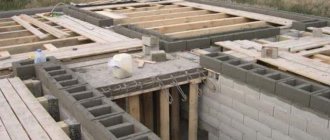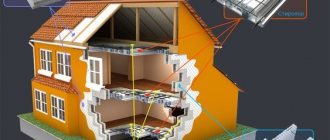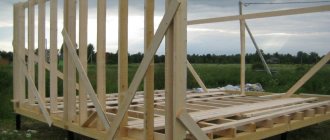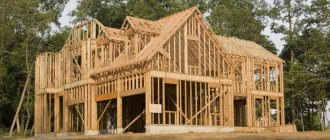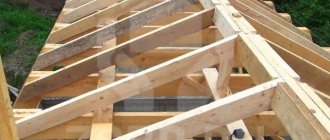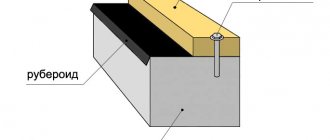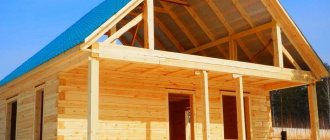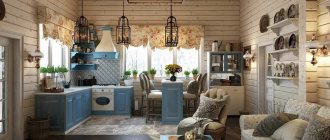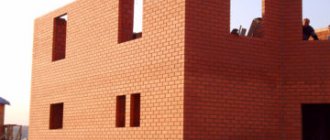What is a SIP panel
The construction of houses from SIP panels began in the second half of the last century in Canada. The technology is simple, the construction of a building requires very little time (from two to three weeks, depending on the complexity of the project), only a frame house can be cheaper, and even then not in all regions.
Houses are built from thermal insulation panels, which themselves have sufficient strength. In English, these panels are called SIP, which is an abbreviation for the following name: StructuralInsulated Panel. This translates as “Structural Thermal Insulated Panel”. It turns out, in theory, in Russian, the name of this material should sound like KTP. In reality, normal transliteration is used (replacing English letters with Cyrillic alphabet). As a result, the name “SIP panels” is in use.
SIP panel and installation method with beams
This material consists of two OSB boards, between which a layer of expanded polystyrene (foam) is laid. The result is a kind of sandwich (a construction “multi-layer sandwich”). Hence another name - sandwich panels .
When building a house, there are two types of assembly:
- With a frame (frame-panel technology). In private housing construction, wooden beams are used; in the construction of high-rise buildings (there are such), the frame is made of steel.
In frame technology, panels are connected using wooden beams
- Frameless technology involves connecting panels using thermal keys - strip inserts made of SIP panels of smaller thickness.
In our country, the first option is most popular. The wooden frame gives the structure additional strength. The load-bearing capacity of sandwich panels without a frame is more than enough for the construction of one or two-story private houses. But knowing that the house is built on solid timber is reassuring. This technology has one more advantage - maintainability. If there are problems, you can remove the damaged panel and replace it with a new one, which is impossible with frameless technology.
Sandwich panel house projects
Structure of a house made of SIP panels
Standard designs of houses made of sandwich panels are an integral part of every building. After all, the quality and durability of the future structure depends on the accurately completed project. For the most part, design bureaus create ready-made custom building plans based on the requirements and wishes of the customer. Most often they are used in the construction of small hotels, shopping centers, and cottages.
The main advantage of these projects is the lightness, ease of transportation and mobility of all materials.
Projects of one-story frame houses
Projects of frame houses with an attic
See more house projects in the “House Projects” section on our website.
Advantages and disadvantages
Like any new technology for our country, building a house from SIP panels has its adherents and opponents. Opponents have the most important argument - the unnaturalness of the materials and the possibility of releasing harmful substances. Indeed, these boards consist of foam and OSB. Polystyrene foam is a common material and is only dangerous when it burns. OSB has also been on the market for a long time; it is made from pressed large shavings and wood chips. Resins containing formaldehyde are added as a binder. It is this binder that raises the most questions: formaldehyde is a strong poison and its presence in the atmosphere in large quantities causes poisoning.
Formaldehyde emissions must be controlled by the SES (sanitary and epidemiological station), and only safe building materials must be put on sale. So if you are planning to build a house from SIP panels, carefully choose the manufacturer - the quality of the material depends on his integrity. Panels assembled using German OSB are recognized as the highest quality and safest. Their formaldehyde emissions are E1 (safe).
Excerpt from GOST R 56309-2014 (date of introduction 2015-07-01): “Depending on the content (emission) of formaldehyde, slabs are manufactured in emission classes E0.5, E1 and E2.”
| Formaldehyde emission class of slabs | Application of slabs |
| E0.5; E1 | As structural elements of residential and public buildings, including for public premises, as well as products and structures used inside residential premises |
| E2 | For industrial products used outside residential premises |
At the same time, they easily tolerate high humidity, do not absorb water and are not deformed.
SIP panel Egger E1 2800x625x174 (Romania) is the best option for walls. Height - 2800 mm, thickness of expanded polystyrene - 150 mm. If you prefer “standard” ceilings with a height of 2.5 meters, then you should purchase Egger E1 2500x1250x174
German Glunz Agepan panels are also good, but few people use them. If we talk about Russian manufacturers, then you should pay attention to the products. Only safe and high-quality materials are used in production:
1. OSB-3 Kalevala Russia emission class E1; 2. Glue – TOP-UR (Russia); 3. Expanded polystyrene – PSBS – 25C Knauf (Russia).
Speaking about the advantages of construction from SIP panels, it is necessary to pay attention to the fact that the technology has been thoroughly developed. Panels are produced for various elements of the house: external walls, partitions, interfloor ceilings, etc.
Each part of the building has its own panels
Why do people build houses from SIP panels? Because such a house has solid advantages:
- Light weight, which allows you to save on the foundation. Pile or pile-grillage foundations are ideal for this type of building.
- Low heat loss, low heating costs. Expanded polystyrene is an excellent insulation material, and it is sandwiched on both sides with OSB sheets. This is what makes a sandwich panel house very warm.
- Low cost per square meter.
- Short construction time. The box of a two-story house can be assembled in a month.
- No shrinkage. There may be settlement at the foundation. The structure made from SIP panels has no settlement.
- Finishing work can begin immediately after the box is assembled.
In general, it is this set of properties that makes people choose a house made from SIP panels. They build both permanent residences and seasonal summer cottages. So, with a limited budget, building a house from SIP panels can be a very good solution.
Features of designing houses from SIP panels
A wide variety of offers makes it easy to find an option with the right parameters. We have affordable SIP house projects that are intended for temporary residence during the summer season. Here it is not difficult to find a property with a suitable number of rooms, a garage, and other architectural and functional additions.
Quick individual corrections based on roof type and other parameters are acceptable. But if such a need arises, the project from SIP panels will be created taking into account special individual requirements. At any stage of preparation, you can use the advice of experienced specialists.
How to build it yourself
There are two ways to build a house from SIP panels with your own hands:
- Buy a house kit for a specific project from a company that deals with this, and assemble it yourself. Not all companies agree to this, but many have a supervising installation service. This is when a company specialist supervises your installation.
- Buy slabs. Cut them to the required sizes, purchase timber, do it all yourself. In this case, all responsibility for the quality of construction will fall on you. If you have carpentry skills or have someone to help you with, you can choose this option.
Briefly about what a house kit is. This is a set of ready-made SIP panels, wooden beams of the required size and fasteners for the construction of a specific house. All components are cut at the factory and numbered. When assembling, you use the resulting blocks in a certain order. The process is reminiscent of building a house from a children's construction set, only you are assembling a real house.
Building a house from SIP panels when ordering a house kit is like playing construction kit
A house kit is good if everything is done accurately. This is not only about the quality of SIP panels (it must be checked separately), but also about the use of dry wood (chamber drying) , and about the accuracy of the cut. The edges of the panels must precisely “grab” the beam, the two panels must be joined with an expansion gap of about 3 mm - all this is achieved using precise equipment.
Reference. The expansion gap is the required distance that is left between building materials that are subject to expansion (dilatation). If a house is being built in a region with a humid climate (for example, the Leningrad region), then it is imperative to leave an expansion gap, otherwise the OSB will swell. In dry climates, there is no need for a gap between OSB.
Construction stages: photo report
Construction of a house from SIP panels, like any other, begins with the selection and construction of a foundation. A pile foundation is considered optimal for a lightweight house. This is exactly what is done in most cases when starting the construction of a house using SIP technology. Sometimes it is impossible to install a pile foundation:
- on hard soils that are too expensive to drill (rocks);
- on unstable soils with low bearing capacity (peat bogs);
- in the presence of cavities in the rock mass.
In these cases, they make a strip or slab (more often USHP is an insulated Swedish stove). They are much more expensive, but more reliable.
A strip foundation or in the form of a slab is also suitable
Once the foundation has been selected and calculated, its construction can begin.
Making a pile foundation
Since foundations are most often made from screw piles, we will illustrate exactly how they are made. Piles are screwed into the ground manually (if the soil and strength allow) or using special equipment. The height of the heads is 80 cm above ground level, the distance between the piles is no more than 2.5 meters.
Screwed piles and caps welded to them
The heads are welded to the installed piles, and the strapping beam is attached to them (in this example, 200*200 mm).
Important! The joints of the timber must be located on the heads. When laying the strapping beams, do not forget to coat the locks with a protective compound (bitumen mastic) before joining.
There is no support under the joint - you can’t do that!
To protect against rotting and insects, the strapping beams are impregnated with a protective compound. Roofing material was laid in two layers under the timber (on the heads).
We attach the timber to the heads and coat it with a protective compound
This stage takes from 3-4 days to a week. It depends on the complexity of the soil, whether you work with the equipment or turn it yourself. Now you can start laying the floor slabs, but before that you should familiarize yourself with the methods of connecting them.
How to connect SIP panels: basic principle
When connecting panels, a wooden dowel (beam) or a thermal key (a piece of SIP panel of smaller thickness) is inserted between them. As mentioned above, in our country the technology using a frame is more popular, i.e. Dry timber is used as a key. It is this option that we will focus on.
The beam is inserted into the groove and fixed using self-tapping screws and/or nails, which are twisted/hammered through the OSB into the body of the beam. If you have a nail gun, we initially recommend tackling the panels with “yellow” wood screws 40-50 mm long, and then punching the joints with rough nails 50-65 mm long in increments of 10-15 cm.
The following can be used to fasten SIP panels: “yellow” wood screws, galvanized screw nails, galvanized rough nails. Do not use “black” hardened screws - they break off and quickly corrode
There is always a risk that the connection will be leaky, and the entire construction technology of SIP panels is based on the thermos effect, that is, on maximum tightness. Therefore, before assembling this unit (and any other), foam is applied to the side surface of the panel. It fills all the cracks, providing the proper level of heat and moisture insulation.
The main unit when connecting SIP panels: joining two panels end-to-end
Note! The picture above shows a dowel made from double timber. Often such recommendations are perceived incorrectly, and in order to save money, unplaned edged boards 50x150x6000 mm of natural humidity are purchased. Once the board dries, the joint is unlikely to remain sealed.
If you are not limited on funds, we recommend using solid timber from dry planed wood, chamber dried
When making a composite wooden dowel 100*150, in our opinion, it is preferable to use three dry bars with a cross-section of 50*100 mm - in this case the connections overlap (see video below).
If we are talking about wall panels, then it makes sense to insert and secure the dowels in advance.
The foam was applied, the beam was inserted, and secured with self-tapping screws. Foam was applied to the side edge of the second slab, the groove was placed under the protruding part of the beam, an expansion gap of 3 mm was set, and secured with self-tapping screws. The foam that came out of the seams during the installation process is cut off after polymerization.
This is what it looks like
This technique, with minor modifications, is repeated in any connection of SIP panels. The diagram of this node is presented above.
After cutting the slabs, it becomes necessary to remove polystyrene foam to the required depth. For these purposes, an electric thermal knife (cutter) for foam plastic is used. They come in various designs, but the thermal knife must be equipped with a limiter. Only in this case will you be able to remove polystyrene foam exactly to the required depth. “Overdoing” can lead to the appearance of cold bridges at the junction of the panels.
Electric foam cutter with installed cutting depth limiter
You can make the cutter yourself, but you should not forget about safety precautions when working with electric current .
First overlap
The first floor is nothing more than a floor that does not require insulation. As melted, it is assembled from SIP panels with a thickness of 224 mm and a width of 625 mm. With such a width of the slabs, the wooden beams are spaced at intervals of about 60 cm, which is enough to withstand the load.
If you have slabs with a width of 1250 mm, then they need to be sawn lengthwise into two equal parts.
When installing the ceiling, the panels should be laid like bricks in masonry - with the seams mismatching (staggered). This is necessary to ensure that the seams do not warp when humidity increases.
These are the pieces that floor blocks should be cut into when using 1250 mm wide slabs
To protect the bottom OSB board from moisture, each of the boards is coated on one side with the same bitumen mastic. You can use other compositions with similar properties.
Assembly of SIP floor panels for the first floor
When connecting the slabs, a mounting beam is laid between them (diagram in the previous paragraph). The beam is attached at the edges to the frame (with long nails), and the edges of the slabs are attached to it using self-tapping screws.
We cover the side sections of the slabs (all floors) with an edged board of a suitable size. We apply foam to the side surface of the slab using a snake, then we place a board and fasten it through the OSB with self-tapping screws into the end of the board.
Closing the floor sections
A starting (crown) board is laid on top of the sandwich along the perimeter, on which the SIP wall panels will rest. It is laid around the perimeter and in those places where partitions will be installed.
Method of fastening the first floor and thrust beam
The crown boards are fastened with nails/screws, but to be sure, they were secured through and through with studs to the pile heads. Holes were drilled for the studs. A pin is driven into them and tightened with bolts.
Walling
We continue the construction of a house from SIP panels: we are installing the walls of the first floor. For this work, it is advisable to have two assistants, then the process will go faster and easier.
We place the first panel so that it “fits” onto the crown board
Wall installation begins from one of the corners. When installing, the panel is “slipped” onto the installed starting board with a recess in the lower part (first apply a layer of foam to the board or the end of the sandwich). The panel is placed, aligned vertically, attached to the starting board on both sides with self-tapping screws in increments of 10-15 cm.
Assembly of the wall slab to the strapping beam
Foam is applied to the side surface of the installed slab, and another slab is set at an angle of 90°. An embedded board (end block) is pre-attached to its side part, the thickness of which is equal to the depth of the groove. Like the first one, this panel is attached to the strapping starting board.
We fasten the corner from sandwich panels
In addition, we fasten the corner using long self-tapping screws.
As a rule, self-tapping screws with a length of 220 to 280 mm are used
The length of the self-tapping screw must be such that it passes through the slab and the entire thickness of the embedded board. The installation step of this fastener is 40-50 cm.
The principle of assembling the first floor wall
Next, the walls from SIP panels are assembled according to the same principle: we place a beam between the slabs (if it was not inserted previously), and attach the next slab to it and to the bottom frame. Simple and fast.
In window and door openings, for more reliable fastening, you can install metal perforated reinforced corners. The element is optional, but adds rigidity and inspires confidence.
External walls and partitions are immediately erected
The installation of partitions from SIP panels follows the same principle: we attach a crown board and partition blocks to it. They can be the same thickness as for external walls, but thinner ones can be used. The decrease in sound insulation properties is compensated by the interior decoration.
To save money, partitions can be made using frame technology. Then initially only the frame can be installed, and its cladding can be transferred to a later period. It is more convenient to do this when the roof is already installed.
In a house, frame partitions can be made from SIP panels
Interfloor ceiling
To install floor slabs in the grooves of wall panels, boards are installed on foam and self-tapping screws. They create a harness for installing the ceiling.
Preparing the piping for the interfloor ceiling
Next we lay the floor slabs. If the partitions are assembled from SIP panels, their load-bearing capacity is quite high and no additional reinforcement measures are required. If the partitions were assembled using frame technology, we make the upper beams reinforced: they are assembled from three boards glued together. For greater strength, the beams can also be fastened on both sides with self-tapping screws.
Reinforced beams
Floor slabs made of SIP panels are laid on the finished frame. They should be no more than 625 mm wide and should be laid staggered (with the seams mismatched). Since the panels are narrow, there is a lot of wooden beams in the ceiling. Due to this, such a floor can withstand loads in places where there are no floor beams.
This is what it looks like from above
We fasten the laid slabs to the framing beam with self-tapping screws or nails. The edges of the OSB are at the top and bottom to each intermediate beam. After securing the installation of the ceiling, we close the open side sections along the perimeter of the building according to the same principle: foam + edged board. For greater rigidity, in those places where the floor beams pass, we fasten the floor panels with long self-tapping screws (220 mm) all the way through.
A couple more angles
This stage after assembling the first floor does not seem difficult. Everything is the same, only the work is at height, tightening the sandwich panels takes longer and is more difficult than installing them.
Second floor walls
The second floor in this project is an attic, so the wall panels are low. We also install partitions at the same time as the external walls. Before installing the roof, an embedded beam is installed in the upper open groove; roofing SIP panels will be attached to it.
The outside is much taller
Standard panels will have to be cut to fit the gables, since the shape is non-standard. The installation and connection of the wall panels themselves on the second floor is no different.
Roof made of SIP panels
Special sandwich panels are used for the roof. Under them, the ends of the slabs are cut at a certain angle, which is determined by the angle of inclination of the roof slope. Here, just as with flooring, you can get by with a minimum of beams, because each connection has its own beam. Therefore, the rafter system is not assembled.
For a roof made of SIP panels, beams need a minimum
Skate decoration
The roof of a small to medium sized house is made of SIP panels and usually has a central ridge beam. Here two planes of the roof converge. This node can be designed in two ways (in the pictures below). The first one is symmetrical. The sandwich panels are cut at an angle, and the top of the ridge beam is cut at the same angle. Two planes are fastened with long self-tapping screws through the panel to the beam on both sides. The fastener installation step is 30-40 cm.
Method of connecting two roof planes on a ridge beam with slabs sawn at an angle
In this method, there is no usual timber between the two slabs; they are connected only with foam. After the foam has polymerized, the excess is cut off, the seam is treated with a waterproof sealant, after which a protective strip - made of metal, plastic, etc. - is put on the ridge. - depends on the type of roofing chosen.
There is another way to join roofing SIP panels on the ridge. The second method does not require cutting the slabs at an angle, but one part of the panels must be longer (by the thickness of the roofing slab). The beam is still cut at an angle, the slabs are joined at right angles, and fastened through and through with long self-tapping screws to the beam.
Docking without undercuts
This connection uses embedded end bars. They are installed as usual - using mounting foam and self-tapping screws. To block the access of moisture to the under-roof space, the junction of the two panels is also additionally coated with a waterproof sealant.
There is an option to install a roof from SIP panels without a central beam. There are roofing options with two load-bearing beams that are located off-center. These can be either specially laid floor beams, or partitions assembled from SIP panels or using frame technology. In the second case, it is better to strengthen the beams (make them prefabricated with glue and nails).
If there are two rows of partitions or two load-bearing beams
The most difficult thing in this unit is to cut the embedded beams at the right angle. This can be done on the ground, which greatly simplifies the task. The panels are fastened through the slab with long self-tapping screws to the floor beams or mortgages in the partitions. Also, two planes are fastened together at the junction point - on opposite sides with long self-tapping screws.
Roof and wall panel connections
For laying SIP roofing slabs, wall slabs are cut at the required angle. The inner part of the OSB is higher than the outer part. The foam plastic is “cut” at the same angle, and the edges of the embedded beam are trimmed. It is this part that is the most difficult if you did not buy a house kit, but are building a house from SIP panels using standard panels, cutting them to the required dimensions with your own hands.
How to connect wall and roof SIP panels
If you have the appropriate equipment, cutting them at an angle is not a problem. The problem is cutting the foam between the OSB boards to the required depth. You can select the core using a thermal knife, and then remove the residue purely mechanically. Most likely, the cut will still not be smooth, so you will have to add more foam to fill the unevenness.
If the roof overhang is made without insulation
In the pictures, the roof overhang is also made of slabs with insulation. This is easier to implement, but it is an unreasonable expense. To save money, the length of the SIP panel is taken up to the intersection with the walls, and then only the timber goes (as in the photo). In this case, the beam is made composite: one part is longer by the amount of the overhang, the second is shorter and ends where the wall ends.
Features of joining roofing slabs
The connection of two roofing slabs occurs in the same way as others: timber, foam, self-tapping screws. But since precipitation is possible here, it is advisable to seal all seams.
Assembling a roof from sandwich panels
To improve the tightness, all seams on the roof are additionally coated with waterproof sealant. First, the hardened foam is cut into a plane with the roof, then a sealant is applied. After filing the overhangs, we can consider that the construction of a house made of SIP panels is completed. Install windows/doors, connect communications and the home is already suitable for habitation. Finishing can be done immediately after installing the box.
Interview with Oleg Kilin: apartment building using SIP technology
Every company has products that serve not so much to make a profit, but to demonstrate technological potential and bold ideas. Car manufacturers bring concept cars to exhibitions that elevate completely new trends in the design and equipment of cars, computer assemblers produce futuristic gaming systems and fault-tolerant workstations, construction companies install the maximum possible options in their demo houses. All these techniques are justified and effective, but the best demonstration of a company’s capabilities remains the products actually used.
What if one does not contradict the other? What if you can build an unusual object that can demonstrate the full engineering potential of its more important purpose than self-promotion? For us, such an object was an apartment building, built by order of Agrotekhnika CJSC for the resettlement of citizens from emergency housing. Read about how we adopted the experience of Finnish builders, and why SIP panels do not limit the house to just two floors in an interview with Oleg Kilin, Deputy Director of Agrotekhnika CJSC.
— Oleg Alekseevich, the house built to your order was recently visited by the governor of the Leningrad region and the plenipotentiary representative of the President of the Russian Federation. In your opinion, does the project deserve such attention?
“Probably, this visit confirms that we are not ashamed to show our house to the highest guests and, most importantly, that our house combines all the qualities that make it comfortable for our customers to live in.”
— There is an opinion that such projects can become the optimal solution to the problems of the Presidential program for the resettlement of citizens from dilapidated housing stock. Tell us a little about the initial concept of this house: what were the requirements for the future building at the initial stage?
— Since this is still a social project, at the preparation stage we set ourselves several tasks:
- The ability to assemble a house from sections, based on their required number;
- Optimal apartment layout, close to social norms;
- The ability to change the types of apartments in a section based on the request of the customer or buyers: for example, increase the number of two- or three-room apartments in a section.
- Low construction costs.
- Reducing bureaucratic procedures during construction.
— Frame-panel technology is usually considered in the case of individual residential construction, although in reality its capabilities are much wider. When planning the construction of this facility, did you consider the option of a house made of SIP panels, or were you primarily focused on other technologies?
— Having studied the experience of Finnish house builders, we immediately proceeded from the possibilities of wooden house construction, including those based on SIP panels.
— What seemed to be the main technological advantage of competing solutions at the technology selection stage, and what could SIP panels counter to this?
— The main competitive advantage of other solutions (brick, block housing construction, etc.), oddly enough, is their “familiarity” for our consumers. Such houses are literally subconsciously perceived as durable and reliable. SIP panels, for all their advantages, have not yet won a place in the hearts of consumers, and in my opinion, this is the only serious disadvantage of this technology.
— The construction of an apartment building using frame-panel technology is quite a difficult task in the sense that for developers this is not a very typical project. How many companies operating in the St. Petersburg market were ready to take on this project?
“We seriously discussed this project with three companies, but the first of them was not ready to quickly produce panels and carry out construction work; the second’s proposal turned out to be significantly more expensive. Thus, the best option remained “Canada House”.
— How did you get involved, and what seemed to be our key advantage at the stage of choosing a contractor?
— We came across your company completely by accident, based on information on the Internet. The key advantage was the experience of working with multi-storey buildings using SIP technology, and, of course, the cost of the work.
— How detailed did our employees inform you about the characteristics and capabilities of frame-panel houses? Was the initial consultation the stage at which you finally decided on the choice of construction technology?
— By the time we discussed the details of the project, I was already familiar with the features of the technology, so we immediately moved on to more detailed features of the project.
— How did our specialists react to the task of building an apartment building? Was it perceived as something ordinary, or did it cause any difficulties? Were there any attempts on the part of employees to impose their own opinions or any alternative solutions on you?
— In the process of work, we repeatedly changed and clarified some of the architectural solutions of the house, adapting it to the peculiarities of the “Canadian House” technology, defended our vision of technological solutions, and made compromises. In other words, the project development process took place in a completely ordinary way; I can’t say that the experts have your own vision of the situation.
— The design of the house was completely original and did not contain common elements with the apartment buildings of the “Ladoga” series from the “Canadian House”. What special requirements did you have for the project?
“The most important requirement on our part was to preserve the external attractiveness of the house, its modern design, the layout of the apartments, and at the same time not to increase the cost.
— Using frame-panel technology, were you able to design the house in such a way as to take into account all your requirements? Are there any aspects of the house's layout that could not be implemented, for example, in the case of "masonry" construction?
— Now it’s difficult for me to evaluate other technologies, since we have only implemented this project so far, but, as in any “pilot” project, it has points that should be taken into account during subsequent serial construction.
— How long did it take to develop the project? What was the degree of client involvement in this process? Of course, approval of the architectural appearance and layout always remains with the client, but have you managed to involve your specialists in the development process?
— The project was developed for more than a year, and some minor modifications even had to be made during construction. However, yes, most of the work was done by our designers - KANON Architectural Workshop LLC, for which we are very grateful to them.
— How would you evaluate the work of our design bureau employees in terms of interaction with the client? How promptly did they take into account your comments, if any?
— Since two architectural bureaus were involved in the work on this project, there were comments that were, let’s say, not easy to eliminate. This is the only negative aspect of our cooperation, and yet I cannot help but note that it was necessary to show greater efficiency in interaction with the project architects.
— The speed of manufacturing an apartment building at a factory, of course, differs from a private house due to the larger number of elements. However, how quickly did our production complex cope with this task? Did everything go according to schedule?
— In this matter, everything was done promptly.
— Construction of an apartment building is a much more complex task compared to a cottage. How many specialists did it require? Was it necessary to involve third-party teams, or was all the work done by our full-time employees?
— Most of the work was carried out by Canada House specialists; only narrow specialists had to be involved at the initial stage.
— To what extent did the actual construction schedule correspond to the stated dates?
“There was a noticeable delay in financing the project, which jeopardized its implementation, but we dealt with it together.
— Have you received information about the progress of construction work? If so, in what form and how quickly?
— Information was promptly provided by Canada House employees, but we also constantly asked questions and monitored the progress of the work.
— How would you characterize the organization of work on a construction site? How competently was the calculation of the required materials made, were there any delays with supplies?
— It is worth admitting that there were problems with the supply of materials at the stage of interior finishing, which, of course, affected the speed of work.
— Construction culture is an extremely important issue for clients, especially if a fairly large number of people work on the site, and the site requires lengthy work. How would you rate the qualifications and personal qualities of our specialists?
- A solid four.
— An apartment building, already as a type of object, requires the installation of all engineering systems. How was it done in your case? Were any autonomous systems used, or was the house connected to centralized networks?
— The house was connected to centralized networks, this is both a plus and a minus. Next time we need to pay attention to autonomous heating systems, since public networks are a sore point for our village.
— How competently, in your opinion, was the installation of energy networks, heating and water supply systems in the house carried out? Indeed, compared to private houses, the load on systems and networks in an apartment building is significantly higher. Have there been any emergency situations since the residents moved in? What maintenance do engineering systems require?
- Of all the constant monitoring systems installed in the house, only heating systems require it - in fact, for the reasons stated above. Energy networks, ventilation and water supply do not cause problems; in this regard, the house is operated in a normal manner.
— You also entrusted our company with the interior decoration of the house. Is the decoration of the premises entirely the idea of the Canadian House specialists, or are your ideas and solutions used here?
— For interior finishing, we agreed with the proposal of the design department specialists, who have more experience in this aspect of construction.
— Have you received feedback from residents about the quality of interior decoration?
— Residents are satisfied with the finish; there were some questions about the quality of electric stoves and faucets.
— This house has been in use for quite a long time. How has frame-panel construction technology proven itself over this period? Do the structures and finishing elements of the house effectively resist winter conditions?
— So far no comments have been identified, the apartments are warm in winter. In general, according to reviews from residents, the house turned out to be extremely comfortable for living.
— Were there any legal difficulties associated with the commissioning of an apartment building made from SIP panels?
- No, absolutely none.
— As you know, this project received a flattering assessment from government officials. Do you think that the construction of facilities of this type can help solve social problems?
“We assumed in advance that such a project could eventually turn into a standard solution for our regions. And, if you believe the reviews of the residents of our building, these calculations were fully justified.
— Are you considering the possibility of helping to promote objects of this type through personal recommendations or dissemination of experience in operating a house?
— Of course, this will be useful to everyone interested in building quality housing in the optimal time frame.
— To what extent, in your opinion, are the experience and qualifications of the Canada House employees reflected in the final appearance of the facility? Would it be possible to build a house like this if we collaborated with another company?
— This is a difficult question, I can’t even imagine implementing a project with another company.
Mice and other troubles
To save our readers from unnecessary headaches, we decided to talk about the mistakes made during the construction of one residential building. First of all, the material is intended for those who hire contractors for construction. However, it will also be useful for those who build a house on their own.
The facility was built under the “Rural House” program, and local would-be builders acted as the contractor. Unfortunately, the future residents did not pay due attention to the quality of the work. The result is natural - a large number of significant “jambs”.
Brief information about the house:
- Commissioning date: 2008
- Number of floors: 2
- Foundation type: strip
- Technology: frameless
- Panel sizes: 2740x1220x224 (floors), 2740x1220x174 (walls), 2740x1220x145 (dowel for connecting wall panels)
Problems appeared quite quickly and were associated with the most important part of any structure - the foundation. The strip foundation was filled with low-quality concrete, which led to the fact that when moisture entered, it began to crumble.
Under the influence of moisture, the foundation began to crumble
In extreme cold (below -30°C), another “jamb” was discovered - part of the plastic floor plinth in the kitchen froze.
It was decided to remove the bottom panels of the vinyl siding, remove the cold bridges where the wall slabs adjoin the first floor ceiling, and sheathe the foundation with corrugated sheets to look like stone.
After dismantling the lower siding panels, signs of field mice appeared.
During construction, the ends of the floor were not covered with boards. Pieces of plywood are installed, with large distances between them. Also note that the roofing felt does not start from the timber, but from the floor level
A brief explanation of roofing felt. At the time the house was built, vapor-permeable membranes had not been heard of in a particular locality. The contractor was going to lay plastic sheeting on the walls. The customer opposed this, and as a result, roofing felt was used.
It is clearly visible that the mice did not waste any time...
When the baseboard froze, mouse holes were found and the seam between the OSB was not foamed
As a result, the owner of the house had to mitigate the consequences using his modest construction experience.
The possibility of mice accessing the polystyrene foam was previously blocked, then the foundation was sheathed with corrugated sheets
Related errors:
- The lower part of the first floor ceiling has not been treated with bitumen mastic.
- SIP panels with a width of 1220 mm were laid on the floors of the first and second floors (they had to be cut in half lengthwise).
- Raw wood was used.
- The panel for making thermal keys is thinner than the polystyrene foam layer.
- The corners of the house are not tightened with long screws.
- Self-tapping screws are exclusively black.
There were other mistakes, but we do not talk about them, as they do not directly relate to the technology of constructing SIP houses.
Alas, the case discussed above is not the most severe - the fatal option is discussed in the video below.
The conclusion is very simple: you should not blindly trust the customer. All stages of construction must be supervised personally, or seek the help of a knowledgeable person from the outside.
If the construction is carried out by contractors, then the quality of their work can be assessed already at the stage of acceptance of the first floor slab.
